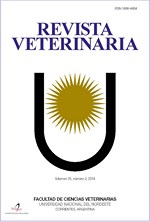Enfermedad respiratoria en vacas Holstein alimentadas con silaje de maíz: reporte de caso
DOI:
https://doi.org/10.30972/vet.3427056Palabras clave:
rumiantes, tambo, disnea, maíz, gases tóxicosResumen
Se describe un brote de enfermedad respiratoria en vacas Holando Argentino, inmediatamente luego del consumo de un nuevo silaje de planta entera de maíz, presuntamente con presencia de gases neumotóxicos. Se observaron signos en el 10% de las vacas, caracterizados como taquipnea, posición ortopnéica, episodios de tos y ansiedad, unos minutos luego del ofrecimiento del silaje. No se registraron muertes. En el hemograma se observó leucocitosis leve. El análisis de calidad nutricional del alimento y la concentración de nitratos en el silaje de maíz resultó con los valores habituales. Se evaluó la concentración de óxido nitroso y metano en una muestra de silaje de maíz recolectada herméticamente por cromatografía gaseosa, así como la concentración de óxidos de nitrógeno in situ con un instrumento portátil, resultando en valores aceptables. Aunque no se pudieron evidenciar concentraciones de gases elevadas en el aire del silaje muestreado en el tambo, los signos clínicos observados coinciden con los casos reportados de exposición a gases que se forman durante la fermentación del ensilado. Se debería tener en cuenta la evaluación del maíz a ser ensilado, dadas las posibilidades de que se genere la acumulación de gases potencialmente tóxicos para el ganado, que puedan afectar negativamente su salud y productividad.
Descargas
Citas
Bolsen KK. Silage review: Safety considerations during silage making and feeding. Journal of Dairy Science. 2018; 101: 4122-4131.
Cutlip RC. Experimental nitrogen dioxide poisoning in cattle. Vet. Path. 1966; 3:474-485.
Driehuis F, Wilkinson JM, Jiang Y, Ogunade I, Adesogan AT. Silage review: Animal and human health risks from silage. Journal of Dairy Science. 2018; 101: 4093-4110.
Epler GR. Silo-filler’s disease: a new perspective. Mayo Clinic Proc. 1989; 64: 368-370.
Grayson RR. Silage gas poisoning: nitrogen dioxide pneumonia, a new disease in agricultural workers. Annals Int. Med. 1956; 45: 393-408.
Maw SJ, Johnson CL, Lewis AC, Mcquaid JB. A note on the emission of nitrogen oxides from silage in opened bunker silos. Environ. Monit. Assess. 2002; 74: 209-215.
O’Kiely P, Turley T, Rogers PA. Exposure of calves to nitrogen dioxide in silage gas. Vet. Rec. 1999; 144: 352-353.
Peterson WH, Burris RH, Sant R, Little HN. Toxic gases in silage, production of toxic gas (nitrogen oxides) in silage making. J. Agric. Food Chem. 1958; 6: 121-126.
Spoelstra, SF. Nitrate in silage. Grass Forage Sci. 1985; 40: 1-11.
Verhoeff J, Counotte G, Hamhuis D. Nitrogen dioxide (silo gas) poisoning in dairy cattle. Tijdschrift voor diergeneeskunde. 2007; 132: 780.
Descargas
Publicado
Cómo citar
Número
Sección
Licencia
LicenciaPolítica de acceso abierto
Esta revista proporciona un acceso abierto inmediato a su contenido, basado en el principio de que ofrecer al público un acceso libre a las investigaciones ayuda a un mayor intercambio global de conocimiento. La publicación por parte de terceros será autorizada por Revista Veterinaria toda vez que se la reconozca debidamente y en forma explícita como lugar de publicación del original.
Esta obra está bajo una licencia de Creative Commons Reconocimiento-NoComercial 4.0 Internacional (CC BY-NC 4.0)










.jpg)
.jpg)



